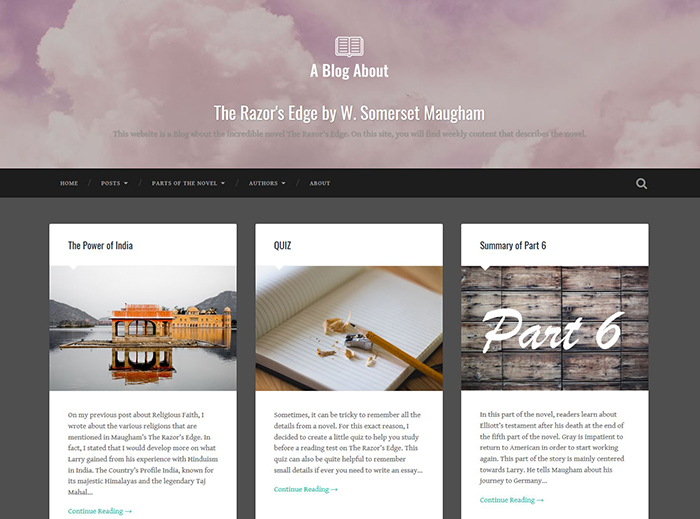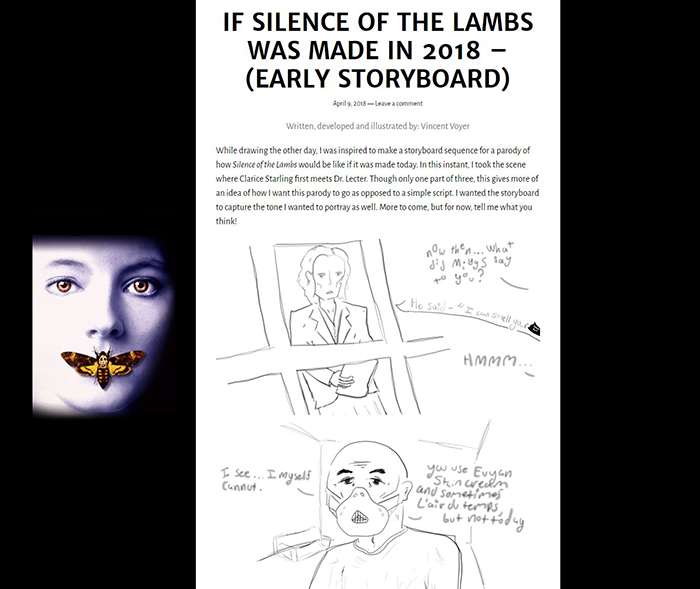A Student-Centered Blogging Project Combining Business and Literature
In the winter 2017 semester, I did some research on Inclusive Pedagogy and came across Learner-Centered Teaching, a book by Terry Doyle and Todd Zakrajsek that had me rethink the way I considered my role as a teacher. The book spoke so much to me that I very soon longed to experiment with its theories in the classroom. I literally turned my course upside down halfway through the semester in Long Fiction for Business, a program-specific core English course in the Business program at St. Lawrence. I moved on from a traditional lecture-based approach to a complete blog development project. I did not realize how much of a career-changing experience it would become.
The premise to Doyle and Zakrajsek’s text is that the person who does the work does the learning. Naturally, if I did all the research to prepare for classes and deliver the material, I was learning as I did so. But could I guarantee that the experience was optimal for the students to learn, too? Doyle and Zakrajsek present 3 stepping stones to a learner-centered environment:
- Engaging students by providing them with authentic, practical situations, and involving them in the development of evaluation methods and timeliness of evaluations
- Being flexible by letting students determine their own roles in class and by creating assessments that make the evaluation of different skills equitable
- Being clear by developing very precise evaluation criteria and rubrics and providing students with regular feedback
The blog project encompassed all 3 precepts, and I plunged headfirst into what was to become one of the most rewarding teaching experiences of my career thus far.
Designing a suitable project
I kept Doyle and Zakrajsek’s 3 key principles in mind as I reflected on how I met them in my “regular” way of teaching. I reviewed the generic course plan to make sure my new project would coincide with the ministerial requirements. Engaging students was the element I wanted to put more emphasis on, especially in the context of a fiction course for technology students. I wanted to:
- Make them more interested
- Increase their awareness of the importance of communicating effectively
- Allow all students to use their individual strengths while preparing them for the workplace
The business blog project allowed me to meet all of those objectives.

Example of one team’s business blog promoting the novel they chose.
Many businesses have started hiring companies or individuals that specialize in blogs, because developing a blog can be done at a very small cost with very positive repercussions. This is why I chose this form of communication, given that it is clearly program-specific. The literature component fits into this as the product I wanted my students to promote, that is to say a novel. Thus, I managed to keep the literature component of the course while creating an authentic and practical learning experience that students could even add to their C.V.
Making the project student-centered
As I developed my Long Fiction for Business project, I sought ways to include student-centered pedagogy, to make the learning inclusive and to alleviate stress in ways that allowed me to challenge the students:
- I announced to students that the course would change significantly after Reading Week.
- Before Reading Week, they formed teams of 4 to 7 people. I let them choose their partners in an attempt to be flexible. My purpose was to make the project inclusive, and making differences disappear rather than stand out.
- Students had to agree on the choice of 1 novel out of the 2 left to study. This still respected the generic course plan, yet allowed the students to feel empowered as to which book they would focus on based on their interests.
I gave them Reading Week to read the novel they had chosen, and then I explained the project to them:
You are the owners of a company that specializes in blog development, and have been hired by a business in the cinema industry, specializing in the production of adaptations of classics from literature. Your mandate is to create a blog on the novel to raise people’s awareness of the book prior to launching the new movie.
The students’ reaction was extremely positive. Their level of enthusiasm contrasted very sharply with their attitude at the beginning of class that day, which I found encouraging.
Setting expectations for a business blog
Next steps included differentiating a blog from web pages and developing a working definition of a corporate blog. I emphasized that any business or organization putting together an effective blog had to plan it properly, and I then asked them to read different blogs and identify some that they liked. Students were asked to list elements they thought successful, or less so, on these blogs.
This allowed the discussion to evolve to what a good blog needs to contain, and what would be expected of them in the context of this blog project. I told them that the evaluation would be threefold:
- A team grade for the blog as a whole
- An individual grade for each student’s contribution
- An evaluation of students’ digital citizenship skills (commenting on each other’s blogs)
Teacher and student roles
In order to write what we had defined as a successful blog, the teams reflected on their objectives, their target audience, and the tasks necessary to launch and support the blog. The students were asked to use mindmapping first, and then to proceed with the development of their organizational chart. As they went along, I asked them questions:
- Should creative content be included?
- Is the use of audiovisual support appropriate?
- Should one person be in charge of it?
- Are you comfortable correcting your own blog posts, or should someone (or people) in the team be assigned the role of proofreader?
- Do all team members want to be blog administrators, or is it more pertinent to give such authority to one or more people in the team?
I deliberately avoided imposing roles upon any student. I was just a facilitator in the discussions, and let them take their own decisions. This allowed students to pick the roles that they felt most comfortable with. Creative people put themselves in charge of developing the creative content on the blog. Those who were particularly good at using technology chose to be in charge of creating the structure of the blog online and of maintaining it thereafter, sometimes even of uploading their peers’ posts. All students showed real interest in the tasks and responsibilities, and I could see that they all felt involved in the process.

In each team, students could divide the work based on their interests and talents, for instance in visual arts.
The students were asked to share their blog plan and organizational chart with me via Google Docs so I could annotate it, and also so they could modify it as they went along, as in any business.
All the lectures on literature I had planned transformed very radically from that point on. Among the many topics I addressed in class as part of the blog project, I spent time suggesting different types of blog posts, explaining how to develop and maintain traffic, presenting copyright issues for online material, helping them with language use, etc. Literature still was the object of discussions and explanations, but in the form of half-class sessions attended only by the students who had selected a particular novel, while the others worked on their blogs.
Students experimented with different presentation formats, while keeping the main focus on their novel.
The Main Challenges and Rewards of the Project
Having to change my evaluation methods completely was one of the most demanding elements of my new approach. Multiplying the 3 aforementioned forms of evaluation done simultaneously really made me feel like an octopus as I constantly switched from one rubric to another and yet another when I did the summative evaluations. However, the variety of the material I read kept me on my toes at all times as opposed to a more standardized form of evaluation. And last but not least, the quality of the work done by the students far exceeded my expectations. Some of the blogs were so good that they could be used by teachers to prepare their classes. The class average prior to Reading Week had been somewhat low, but there was a significant boost in grades with the blog project that I can only relate to the level of the students’ engagement in their learning. It may very well have been a sudden and radical overhaul of my teaching methods, but the unanimously positive response I received from my students in the semester-end survey convinced me to repeat the experience in the future, which is exactly what I am doing in winter 2018.

